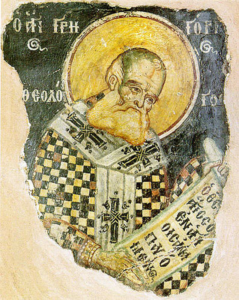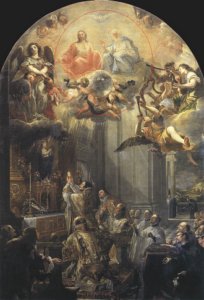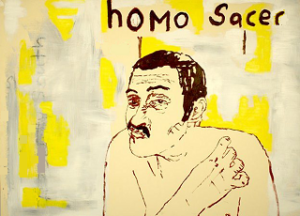
Arquivo para a ‘Noosfera’ Categoria
The Trinity and Contemporary Christian Philosophers
Works on the trinity in Christian patristics include the work De Trinitate by Augustine, the Cappadocian priests: Saint Basil and Saint Gregory of Nazianzeno (image), João Damasceno and Tomás de Aquino, these from Antiquity to the Middle Ages, who worked at pericoresis in the Trinity.
work De Trinitate by Augustine, the Cappadocian priests: Saint Basil and Saint Gregory of Nazianzeno (image), João Damasceno and Tomás de Aquino, these from Antiquity to the Middle Ages, who worked at pericoresis in the Trinity.
I begin with a reference that I consider important for the adoption of phenomenological and hermeneutic thinking, the work L´Idole et la distance (1977) by Jean Luc Marion, he like others depart from Saint Augustine, but as a good hermeneutic he only wants to play “the Trinitarian game [ie, the Trinitarian pericoresis] ”that she take on the desolations including metaphysics, and take us to patience, work and humility.
It refers to pericoresis with a “dance” and desolations are the philosophical criticisms that the 19th century, in particular Nietzsche, made religion, especially the idea of God, will identify that the idea that the death of God would bring to man the light, if we look at reality, we will see that it did not happen, we see a man without humanism, now in the horrors of a pandemic that does not yield and the danger of a civilizing crisis.
Hermeneutics due to its interpretative structure, transmission and mediation “do not refer only to the annunciation, to the communication of God with man, they define the intimate life of God himself, who, for this reason, cannot be thought in terms of a immutable metaphysical fullness” (in the work of Gianni Vattimo: Etica de la interpretación, 1991).
Away from Hegel’s absolute idealism, and advancing the idea of Trinitarian ontology, which began in the early twentieth century, authors such as Pavel Florenskij, Sergei Boulgarov, more recently John Zizioulas and several Italians such as Massimo Cacciari, Bruno Forte, Piero Coda and na Germany Joseph Ratzinger and Klaus Hemmerle, in France we have already mentioned Jean-Luc Marion and Michel Henry.
Piero Coda uses a category of the founder of the Focolare Movement, which is the figure of Jesus Forsaken to make his “Trinitarian dance” a daily relationship with all beings and thus recreates the Trinitarian ontology, which is able to establish a relationship between the Logos expressed in Jesus, and fully realized in his figure when already faint and surrendering the pains and sufferings of the cross, he no longer calls God Father, but only God: “My God, my God because You forsook me” says the biblical account, it seems parodoxy, a pericoresis with man.
Coda says: “in some way the eternal circulation of the love of the Three is communicated to us in history … its opening to the history of men” (Dio uno e trino, Edizione San Paolo, 1993, p. 141).
There was an understanding of this reality, but the hermeneutic interpretation has not yet existed.
The trinity in an anthropotechnical perspective
The whole philosophy of Sloterdijk must be preceded by a good reading of Heidegger, trying to simplify what is per se impossible, we explain the category “without-in” that will be used a lot in his speech on the Trinitarian relationship, from where the “imbricated cosubjectivity of the God-soul dyad” (Sloterdijk, p. 490), where“ theological surrealism hides, as we will show, the first realism of the spheres ”(idem).
a good reading of Heidegger, trying to simplify what is per se impossible, we explain the category “without-in” that will be used a lot in his speech on the Trinitarian relationship, from where the “imbricated cosubjectivity of the God-soul dyad” (Sloterdijk, p. 490), where“ theological surrealism hides, as we will show, the first realism of the spheres ”(idem).
Sloterdijk does not use epigraphs just to decorate the text, in chapter 8 “Closer to me than myself: theological propedeutics for the theory of the common interior”, in the epigraph he explains: “… it means ´be-em´ [In-sein] ?… Being-in … means an ontological constitution of existence (Dasein)” citing § 12 of Heidegger’s Being and Time.
It clarifies in the other quote in the epigraph that “perhaps Em is the envisioned kingdom of all life (of all morals) of God”, quoting Robert Musil in his book “The man without qualities”, which he is today.
Before going into the question of the trinity, he explains that human love “does not exist at all before it is produced” … “in the perspective of individualistic modernity – two loneliness that are uprooted by the encounter” (p. 491), and will return to incident of paradise lost asking if it was not “a painful gap of strangeness?” (idem).
It was Augustine, he explains in the “Confessions” that he took “the dialectic of recognition from ignorance” (p. 492), in his “cryptic masterpiece” De trinitate (in particular books VIII and XIV) “that deal with accessibility of God through the traces left inside the Soul ”(p. 493), and although it traces its contradictions with the theological discourse, he affirms“ it can be considered as the great logic of the intimacy of western theology ”(idem).
The long analysis that goes from page 494 to 524 in which he penetrates the contradictions of the religious discourse, passing through biblical citations, Nicolau de Cusa, Duke João da Baviera, a learned and unauthorized Cardinal in the literature of the Christian tradition, reaches a final verdict, this important yes, which is how Platonic dualism caused “side effects… in doctrines of this type [which] also break the sense of being-in” (p. 524).
Illustrated with the painting by Juan Carrero de Miranda “The foundation of the Order of the Trinity” (oil of 1666), the author proceeds to make the “topographic distribution of the Three in the One”, highlighting in the table the “classic quaternity covers the Trinity and the Universe ”(we highlight it with a small red circle), it would be good if you did it.
Within his spherology, Sloterdijk explains that “echoes characteristic of the philosophy of nature, even though it has been a long time, the cohabitation of spiritual entities”, so we are closer to other “animist” worldviews than we imagine, in a dualistic theology.
Analyzing the discourse of Pseudo-Dionísio Aeropagita, he clarifies that “the pathos of the difference of differences within the One was already known to Neoplatonism, and the“ mutual justification of the principles of the people of the Trinity ”(p. 130) will benefit from it.
He is well aware of the pericoresis of Cappadocian priests (St. Gregory of Nissa, St. Basil and St. Gergorius of Nazianzeno) (p. 540-541), in addition to Augustine used abundantly, he also cites João Damasceno (p. 538, 544-546) and quotes Tomás de Aquino.
SLOTERDIJK, P. (2016). Esferas I: Bolhas, trad. José Oscar de Almeida Marques, Brazil, São Paulo: Estação Liberdade.
Trinitarian thinking in non-Christian authors
Understanding the mystery of being three people, but one God, it is clear that it penetrates into the Christian mystique in its depth, however if we imagine that there may be the key of the human relationship where two people put themselves in a symmetrical relationship, that is, of mutual respect and love, one is inseparable from the other, it can be understood that it is possible for a non-Christian author to understand the issue.
it is clear that it penetrates into the Christian mystique in its depth, however if we imagine that there may be the key of the human relationship where two people put themselves in a symmetrical relationship, that is, of mutual respect and love, one is inseparable from the other, it can be understood that it is possible for a non-Christian author to understand the issue.
We will go through three authors, Giorgio Agamben, Peter Sloterdijk (together with his disciple Byung Chul Han) both non-Christians and how could not help being a Christian, Piero Coda, who introduces us in a new way in this mystery, typical of a charism of the 20th century, which proposes the unity of the human family, what seems difficult and in a certain way tragic (the author himself affirms it), is in fact a new theological opening.
To understand Agamben, it is necessary to understand that part of a very interesting hypothesis, but in our view not enough, that the history of Western culture results from a paradigm resulting from Christian theology, which sees the continuous history of separations and crossings between these two paradigms: the political and economic, forming a bipolar system.
This is described in two of his works: “State of exception” (2003), which in fact always surrounds the West between auctoritas and potestas and, in the work O Reino e a Glória (2011), which can take the formula: Kingdom, Glory and Oikonomia.
Because Agamben’s work is indeed valid, because Oikonomia, which has its origin in classical antiquity, which means organization of the house can and would even be interesting if it were in fact the “organization” of household goods, but the Greek origin itself means no longer Christian.
Where they are confused, in Greek, oikos (house) and nomos (law, rule, norm), were used by Xenophon and Aristotle (in ancient polytheistic Greece) this term designated “the sets of precepts that govern, or should govern, the activity of the ‘lord of the house’ in obtaining the necessary resources for the life of the family ”, and in Christian theology all being brothers, we are in the same “house”, but there, because the argument that Agamben will use of monotheism does not it is valid for the Greeks.
Although Agamben understands that in the book L of Aristotle’s Metaphysics there is already a marked distinction between Kingdom and government, the same book that another critic of monotheism Erick Peterson wrote against political theology.
There God appears as the immobile engine of all things that would ultimately mean a Christian “category”, which in fact could be for some authors, but it is certainly not the Christian God. However, this is not the Christian God, there is no real Trinitarian interpretation in Agamben, but an adaptation of the Aristotelian, dualistic view, being is and non-being is not, for the view of the Trinitarian.
Agamben’s great contribution is in his great work: Homo sacer: sovereign power and naked life, where he addresses the concept of naked life, like that which is found in a gray area of political life, between zoé and bios, the Aristotle’s concept of man as a political animal explained, deepened and updated.
AGAMBEN, Giorgio, (2007) Homo sacer. O poder soberano e a vida nua I. Trad.: Henrique Burigo. Brazil, Belo Horizonte: UFMG.
Clearing and enlightenment
What actually happens if we find the clearing, if through a  process of changing consciousness, self-enlightenment, we abandon old theories, machinations and “see each other” in his difference.
process of changing consciousness, self-enlightenment, we abandon old theories, machinations and “see each other” in his difference.
The answer is in Heidegger himself in his main work Being and Time: “As long as the being comes from the aletheia, the self-unveiling emerges. We call this the action of self-enlightenment and enlightenment, the clearing (cf. Being and time) “.
We have already posted about the difference between aletheia and truth, but now, from the text above, it is possible to unveil a little deeper, the path of enlightenment leads us to a possession that gives meaning to who we are and what we receive: to be. In enlightenment there is a sense of being and performs an ontological path and not merely temporal or spatial, this connection to the temporary hides the original meaning of all space and time, of all times and of all relationships with the world, this is the enlightenment.
It is not my definition, other readers of Heidegger make a very practical reasoning similar to what is done here, for example, the text by Manuel de Castro found on the Web, which states that “in the enlightenment the sense of being happens in us”, it is not a matter of chance and there are many other possibilities for this enlightenment, all religions, for example, seek this enlightenment, most philosophers believe they have found it, but what it really is.
I launch the appeal of religions, especially the Christian one that I profess, but I cannot help imagining that the same is possible in others, there is something that can be called “seeds of the verb” and that in some way are present in the great religions, in Christian is the action of the “Holy Spirit”.
This node that can unite us to an enlightenment, is the one that “unites us all”, is that thought that Edgar Morin said: “it is necessary to replace a thought that isolates and separates with a thought that unites and distinguishes”, therefore living in unity with the different others.
The word that speaks of this action through a special gift from the Holy Spirit that made everyone who heard it understand in their own language (one can think of a metaphor according to the possible understanding of each), says the passage (Acts 2,4-6 ):
Everyone was filled with the Holy Spirit and began to speak in other languages, as the Spirit inspired them. Devout Jews lived in Jerusalem, from all the nations of the world. When they heard the noise, the crowd joined, and everyone was confused, because each one heard the disciples speak in their own language ”, at some point in our history this can happen.
What is expected is a more fraternal world where the different can live in their dignity and be understood in their own language.
CASTRO, Manuel Antônio de. “Ser e aparência”. (Being and appearance). Available in: http://www.travessiapoetica.blogspot.com
Dwelling and the clearing
Both dwelling and the clearing precede the idea of Being, since ancient philosophy, Being is also “home”, but modern philosophy has recovered language, an event called linguistic turnaround, and Heidegger’s phrase is worth: “Language is the house of being ”means an ontological identification between being and language.
since ancient philosophy, Being is also “home”, but modern philosophy has recovered language, an event called linguistic turnaround, and Heidegger’s phrase is worth: “Language is the house of being ”means an ontological identification between being and language.
What is this “home” means what is being while being, means removing from being its adjectives to be what is, for example, man as a man without his color, religion, sex, nationality, age, culture, nothing that particularizes it and separates them from each other, this is where we find being.
That is why Heidegger’s definition of language, but in a broad sense any form of communication from a simple look to a long speech, and even the use of some apparatus to enrich (or impoverish, of course) language.
To inhabit the clearing therefore requires first that we unveil what this Being is, and then the being that is what is worth to be, while the “being-there” (Dasein) is what is in the being.
This was veiled in history, and even more in modernity, which projected the whole being on the being, that is, under its characterization and determination, but what it is has been veiled.
Gorgias (485-380 BC) was the first in the history of philosophy to deny the existence of being, for this he also had to deny reason, and existence in absolute, “nothing exists absolutely”, so there is no truth, it is the principle that today we call relativism.
The existence and reality of Being, although veiled, is the possibility of a clearing, an opening for transformation will depend on it, for change both in the human relationship, since this is the fundamental language of being, as in the relationship with nature, which it also determines the being-there.
Everything can become unveiled if we remove the veil that covers being, and we also discover its interiority, which the philosopher Byung Chul Han calls negativity, which is his reflection under what he is, seeing himself as in a mirror, and so on. to be able to see oneself as Being.
An oriental philosopher reads the “clearing”
Byung Chul-Han is a Korean-German philosopher who migrated to the West and does an odd reading of Western literature, in particular the context of networks and new media, studied in his doctorate Heidegger and with this his “clearing”.
to the West and does an odd reading of Western literature, in particular the context of networks and new media, studied in his doctorate Heidegger and with this his “clearing”.
He explains what the clearing is in a simple way: “Heidegger’s ‘truth’ loves to hide. It is not simply available. It must first be ‘taken off’ from its ‘veiling’. The negativity of ´veiling´ actually inhabits as its ´heart´ ”(Han, 2018, p. 74) and in this excerpt he quotes Heidegger´s work:“ On the question of thinking ”.
It penetrates what information means, the great input of the current veiled Being, “the information is lacking, on the other hand, the interior space, the interiority that would allow to withdraw or to be veiled. It doesn’t beat, Heidegger would say, no heart ”(Han, 2018, p. 74).
This absence of counterpart, is what Chul Han calls negativity, it is good to explain it well, “a pure positivity, a pure exteriority characterizes the information”, so is the reflection.
As the information of negativity would then be, in the sense of reflection, it is the “selective and additive information, while the truth is exclusive and selective. Unlike information, it does not produce any pile [Haufen] ”(Han, 2018, p. 74).
Thus, there are no “masses of truth” but “masses of information”, it is the “massification of the positive” (Han, 2018, p. 75), so information is distinguished from knowledge, and this is not “simply available”, I would say neither simply because it is complex nor available because it is hidden.
However, the philosopher confuses it with life experience, when he affirms: “not infrequently, a long experience precedes it” (page 75), and affirms only one side of the information: “the information is explicit, while knowledge often takes a implicitly.”.
Clarifying these two confused points, first the question of experience, the philosopher Plato was the first to announce that wisdom, as knowledge of the truth is not the result of age, if it were only in old age people would deserve to be heard, the other question is about tacit information, it exists as tacit knowledge, Michael Polanyi (1958), was one of the first theory, and Collins in the seventies returned to the concept in the scope of scientific communication. For this tacit information, Chul Han also points this out, “silence” is needed.
The deepest clearing the philosopher describes quoting Michel Butor, who gave an interview to Die Ziet on 07/12/2012, which points to the real cause: “The cause [of this] is a communication crisis. The new means of communication are worthy of admiration, but they cause a hellish noise ”(Butor apud Han, 2018, p. 42).
References:
POLANYI, M. (1958) Personal knowledge – towards a post-critical Philosophy. Chicago: The University of Chicago Press.
COLLINS, H. M. (1974) The TEA set: tacit knowledge and scientific networks. Science Studies, v.4, p.165-186.
HAN, B. C. (2018) No enxame: perspectivas do digital. No Enxame: perspectivas do digital (in portuguese). Trad. Lucas Machado. São Paulo: Editora Vozes.
The possible, but difficult “clearing”
 The concealment of knowledge also hides a concealment of knowledge, without any kind of clairvoyance, access to knowledge becomes attached to mental, logical or ideo-logical schemes that in turn are attached to contemporary thought.
The concealment of knowledge also hides a concealment of knowledge, without any kind of clairvoyance, access to knowledge becomes attached to mental, logical or ideo-logical schemes that in turn are attached to contemporary thought.
The way Heidegger saw the clearing, it was difficult to assess even for his closest students like Hanna Arendt and Husserl, just to name big names, but in his school of thought many still remain stuck in idealism.
The central problem of idealism, for Heidegger, is that through the a priori categories of understanding, all the properties of objects are determined (as if it were only “logical” to know them) and so beings cannot manifest they are pure essence of what are, out of the “logical”.
Thus, between fundamentalist occultism, clearly problematic, and Western “scientific” thinking, as said by Heidegger “established itself as the only measure of man’s habitation in the world”, said in his text The end of philosophy and the task of thought.
In his text Plato’s doctrine of truth, he begins by translating Eidos (the Idea as it was badly translated) as an aspect, which is not an entity in its mere appearance, as it is immediately perceived by the senses, before showing the being appears and can be captured by the intellect (Heidegger, 2007, p. 3).
The other question pointed out by Heidegger is about the explicit translation of “alethéia” by unveiling and that cannot be identified with “truth”, “the question of unveiling as such, is not the question of truth… we should not translate alethéia by the current word truth ”(Heidegger, 1972, p. 36), and thus“ the statement of an essential transformation of truth is also not sustainable, that is, [Plato’s] transition from unveiling to rectitude ”(Heidegger, 1972).
What this implies is not clearly obvious, but it is the clearing itself (in the middle of the forest), that is, clarity, it is only possible in a space of previous opening, something that appears, a “presentation”.
Said explicitly by Heidegger himself: “The ray of light does not first produce the clearing, the opening, it just travels through it. [It] can only shine if the opening is already guaranteed “, so it is an event in time, and perhaps this time of concealment of the Pandemic precedes a” clearing “.
Heidegger, M. O fim da filosofia e a tarefa do pensamento. São Paulo: Livraria Duas Cidades, 1972.
________. La doctrina de Platón acerca de la verdad. Eikasia, Revista de Filosofía, v. 12, extraor- dinario I, 2007.
.
O problema central do idealismo, para Heidegger, é que mediante as categorias a priori do entendimento, determina-se todas as propriedades dos objetos (como se fosse só “lógico” o conhecer) e assim os seres não podem manifestar são essência pura do que são, fora do “lógico”.
Assim entre o ocultismo fundamentalista, claramente problemático, e o pensamento “científico” ocidental, como dito por Heidegger “se estabeleceu como única medida da habitação do homem no mundo”, dito em seu texto O fim da filosofia e a tarefa do pensamento.
Em seu texto A doutrina da verdade em Platão, ele começa traduzindo Eidos (a Ideia como foi má traduzida) como aspecto, que não é um ente em sua mera aparência, como é percebida de forma imediata pelos sentidos, antes de se mostrar o ente aparece e pode ser captado pelo intelecto (Heidegger, 2007, p. 3).
A outra questão apontada por Heidegger é sobre a tradução explícita de “alethéia” por desvelamento e que não pode ser identificada com “verdade”, “a questão do desvelamento como tal, não é a questão da verdade … não devemos traduzir alethéia pela palavra corrente verdade” (Heidegger, 1972, p. 36), e assim “também não é sustentável a afirmativa de uma transformação essencial da verdade, isto é, a passagem [de Platão] do desvelamento para retitude” (Heidegger, 1972).
O que isto implica não é claramente obvio, mas é a própria clareira (no meio da floresta), ou seja, claridade, só é possível em um espaço de abertura prévia, algo que aparece, uma “presentação”.
Dito explicitamente pelo próprio Heidegger: “O raio de luz não produz primeiramente a clareira, a abertura, apenas percorre-a. [Ele] só pode brilhar se a abertura já é garantida”, assim é um evento no tempo, e talvez quiçá este tempo de ocultamento da Pandemia anteceda a uma “clareira”.
Será preciso “Mudar de via” afirma Edgar Morin em seu último livro, a humanidade mudará ?
Heidegger, M. O fim da filosofia e a tarefa do pensamento. São Paulo: Livraria Duas Cidades, 1972.
________. La doctrina de Platón acerca de la verdad. Eikasia, Revista de Filosofía, v. 12, extraor- dinario I, 2007.
Idealism and its religion
Beginning with the critique of idealism, in “The German Ideology” (1932), where he talks about Feuerbach, B. Bauer and Stirner, who even call them St. Buer and St. Stirner, for their claim to be theology.
he talks about Feuerbach, B. Bauer and Stirner, who even call them St. Buer and St. Stirner, for their claim to be theology.
If the essence of idealism is the separation of object and subject, I make a purposeful inversion, the essence of religious thinking for Ludwig Feuerbach is the separation of subject and sensible objects, for for him object consciousness can be, although distinct from itself, a consciousness that coincides shortly thereafter when dealing with the religious object, because of its “transcendence” is exactly what makes it return to self-consciousness, I explain.
For Feuerbach, and the sensitive object is out of being (though ontology here is only an appeal), the religious object is in it, it is an intrinsic object, and neither does it abandon it, its moral consciousness leaves it, it is an intimate object. , and even the most intimate, is the closest of all.
His critique of theology using idealism essentially presupposes a critical judgment, the “difference between the divine and the non-divine, between what is and is not worthy of worship,” so that with this dualism it is possible to play all the essence of the divine in the mass grave of the Ideal.
The consciousness of God is man’s consciousness itself to him, this is the Hegelian idealism made religion: the knowledge of God which is man’s self-knowledge, there is no God-self for man.
The negation of the subject is considered irreligious, and its relation to sensible objects, a negation of the subject, is the atheistic religion of Feuerbach, which Marx will turn to call them the Old Hegelians, and seeks to make their inversion here new now. from object to subject, here is the new “religious” version of the Young Hegelians, like Marx, even criticizing Feuerbach’s main atheistic thesis: “thought comes from the subject,” not the object.
It is no longer about Heaven to Earth,” said Marx, but now “from earth to heaven,” that is, from the object to the subject, the labor force and the production, to their divinization (of the object, of money, economy, etc.). If, for Marx, fetishization was the separation of labor from his instrument of labor and commodity, fetishization may be reification (res – thing) or objectification for these young “Hegelians”, where he sees the separation between subject and object. , in religious fetishism is the separation of (sinful) consumption of the individual (seen in self-awareness) to which the religious must “attend” and live his “concrete”. The fair relationship with money, work, health and education is only a surpassing of the idealistic religious view, its consummation in a man in harmonious relationship with the world, and in this case also beauty, poetry and life. healthy would have a perspective, for the “pure” religious not. This religiosity lacks an asceticism that in fact “elevates” them, although they seem as linked to contemporary themes, actually has an idealistic god and not pretending to be realistic as they would wish, their concrete is the modern state god their economy, or the positivist law and his narrow view of justice.Beginning with the critique of idealism, in “The German Ideology” (1932), where he talks about Feuerbach, B. Bauer and Stirner, who even call them St. Buer and St. Stirner, for their claim to be theology.
he talks about Feuerbach, B. Bauer and Stirner, who even call them St. Buer and St. Stirner, for their claim to be theology.
If the essence of idealism is the separation of object and subject, I make a purposeful inversion, the essence of religious thinking for Ludwig Feuerbach is the separation of subject and sensible objects, for for him object consciousness can be, although distinct from itself, a consciousness that coincides shortly thereafter when dealing with the religious object, because of its “transcendence” is exactly what makes it return to self-consciousness, I explain.
For Feuerbach, and the sensitive object is out of being (though ontology here is only an appeal), the religious object is in it, it is an intrinsic object, and neither does it abandon it, its moral consciousness leaves it, it is an intimate object. , and even the most intimate, is the closest of all.
His critique of theology using idealism essentially presupposes a critical judgment, the “difference between the divine and the non-divine, between what is and is not worthy of worship,” so that with this dualism it is possible to play all the essence of the divine in the mass grave of the Ideal.
The consciousness of God is man’s consciousness itself to him, this is the Hegelian idealism made religion: the knowledge of God which is man’s self-knowledge, there is no God-self for man.
The negation of the subject is considered irreligious, and its relation to sensible objects, a negation of the subject, is the atheistic religion of Feuerbach, which Marx will turn to call them the Old Hegelians, and seeks to make their inversion here new now. from object to subject, here is the new “religious” version of the Young Hegelians, like Marx, even criticizing Feuerbach’s main atheistic thesis: “thought comes from the subject,” not the object.
It is no longer about Heaven to Earth,” said Marx, but now “from earth to heaven,” that is, from the object to the subject, the labor force and the production, to their divinization (of the object, of money, economy, etc.). If, for Marx, fetishization was the separation of labor from his instrument of labor and commodity, fetishization may be reification (res – thing) or objectification for these young “Hegelians”, where he sees the separation between subject and object. , in religious fetishism is the separation of (sinful) consumption of the individual (seen in self-awareness) to which the religious must “attend” and live his “concrete”. The fair relationship with money, work, health and education is only a surpassing of the idealistic religious view, its consummation in a man in harmonious relationship with the world, and in this case also beauty, poetry and life. healthy would have a perspective, for the “pure” religious not. This religiosity lacks an asceticism that in fact “elevates” them, although they seem as linked to contemporary themes, actually has an idealistic god and not pretending to be realistic as they would wish, their concrete is the modern state god their economy, or the positivist law and his narrow view of justice.
Ethics and religion.
Ethics and religion have always been related in history, modernity has separated them.
has separated them.
Hegel (1770-1831) despite the criticism of the Kantian model, in an attempt to build a teleological morality he created the “state morality”, which from his work ‘Principles of Philosophy of Law’ goes on to determine how the institutions that mediate it the life of the subjects referring to it as: a person in the abstract (the individual) as is typical of idealism; a moral subject and not a moral society as subjects including the moral state, and thus having an ethical citizen.
For this, Hegel describes a modern state that provides the full realization of the individual’s freedom. For him, each item of this triad (State, individual, Society) can be analyzed separately, but they are products of iterations, which are developed to arrive at the subsequent one.
In the beginning, in §4, Hegel tries to introduce free will as a starting point of law and as a motto for the development of the work, as it is in all idealistic culture about freedom:
“The domain of law is the spirit in general; there, its own base, its starting point is in free will, in such a way that freedom constitutes its substance and its destiny and that the system of law is the empire of realized freedom, the world of the spirit produced as a second nature from itself. ” (Hegel, 1997)
What he calls “realized freedom” will be done through a state conceived by an abstract right, the morality and an ethic that refer to it.
Ethicity was defined by Hegel as: “… the idea of freedom while living well, that in its consciousness it has its knowledge and its will and that, through the action of this conscience, it has its reality.” (Hegel, 1997), this is idealism is the conscience that determines reality.
As the individual has an institutionalized freedom, abstract law is the supposed freedom of free will that is determined in the face of things, classic idealistic division between subjects and objects, between objectivity and subjectivity, so to take possession, become owner, make contracts a knowing subject is created, aware of his rights, not admitting himself, but the ignorance of the current laws and thus of the conscience that each person has before objects, everything is established and guided by the state, by its ethics.
Here, there is a central aspect of our development, because it is in the State that the individual finds the possibilities of the common good to be realized, because in the particular will of each one desires the common good, it will be what makes the citizen a truly free being, that it is nothing but arbitrary interests enshrined by the State.
The moral crisis of institutions (and the state) is due to the construction of an abstract individual, of nations and not of peoples, they are not subjects, what happens is according to moral rules pre-established by interests, but whose ethics are questioned.
In a more recent time, based on studies by Husserl, after Heidegger, and recently by Paul Ricoeur and Emmanuel Lévinas, the ontological ethics is made from the Other.
Paul Ricoeur was influenced and maintained a dialogical attitude with Mounier, Marcel, and many others, maintaining a dialogical attitude with which he maintained a personal relationship.
Looking at aspects of the person (of the Other) of nature here, dialogue with religion is possible.
HEGEL, G. W. F. (1997) Princípios da Filosofia do Direito. Tradução: Orlando Vitorino. SP, Brazil: Martins Fontes. 1ª edição.
Friends and not servants
Friendship is a link that allows for reciprocity, says Byung Chul  Han in his book No swarm: Perspectives of the digital: “Power is an asymmetrical relationship. It establishes a hierarchical relationship. The power of communication is not dialogical. Unlike power, respect is NOT necessarily an asymmetric relationship. In fact, one often feels respect for exemplary people or superiors, but “reciprocal” respect, which is based on a symmetrical relationship of recognition, is fundamentally possible. ”
Han in his book No swarm: Perspectives of the digital: “Power is an asymmetrical relationship. It establishes a hierarchical relationship. The power of communication is not dialogical. Unlike power, respect is NOT necessarily an asymmetric relationship. In fact, one often feels respect for exemplary people or superiors, but “reciprocal” respect, which is based on a symmetrical relationship of recognition, is fundamentally possible. ”
This relationship means that we may or may not be in reciprocity, and we may or may not be in healthy relationships of friendship, affectivity and love (without a sense of agape), it does not mean that other relationships do not exist, for example , civil authority, social or religious for those who should really be respected as “authority” and not by imposition or fear, this case is justified only when there is a clear intention to violate social rights and duties.
In an authoritarian society the only respect is hierarchical, moral rules are forgotten, ethics only serves the logic of power and mutual respect is confused with total “freedom”.
It is not possible to go straight to the plane of love without going through some individual or reciprocal empathy that is the most desirable, even though when the relationship is asymmetrical, someone who has respect manages to remain in some way in an empathic way, even if there are acceptable limits, unless violence, for example.
In the biblical passage that the Master explains to the disciples what kind of love they should have, that love “as I loved you” (John 15:12), he adds: “I no longer call you servants, because the servant does not know what your lord. I call you friends, because I let you know everything I heard from my Father ”(Jn 15.15), this implies a relationship of symmetry and reciprocity as indicated above.
Jesus shows this by washing his feet (photo), but his friendship was over the limit: he gave his life for his friends.
It is also a good harmony of friendship, nobody has more friendship (or love) than the one who gives his life for his friends.

